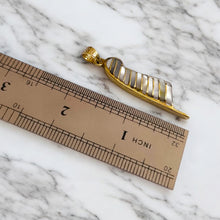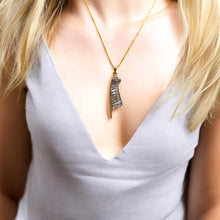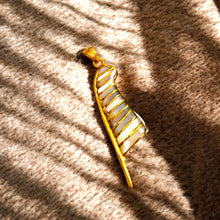
Step into the mystique of ancient Egypt with our Gold Goddess Maat’s Feather Pendant Necklace — a striking symbol of truth, balance, and divine wisdom. Carefully handmade, this piece is both a spiritual talisman and a healing amulet, channeling the sacred energy of Maat, the Egyptian goddess of justice and harmony.
Crafted from a unique alloy of 5% gold and 95% brass, the pendant boasts a luxurious vintage-inspired finish that evokes timeless elegance. At its heart lies a luminous mother of pearl inlay, delicately set to mimic the ethereal glow of a true feather. As light dances across its surface, the colors shift and shimmer, giving the piece a magical, almost living aura.
Designed for both men and women, this pendant fits any chain up to 5mm in thickness, allowing you to wear it your way. Whether worn close to the heart or layered with other meaningful pieces, it serves as a powerful reminder to live with integrity and spiritual clarity.
Jewelry Care
To preserve its beauty and energy, avoid exposing the pendant to water, perfumes, and harsh chemicals. Gently clean with a soft cloth and store it in a dry, cool place when not in use.
Symbolism & Spiritual Significance
The feather of Maat was believed to be weighed against the hearts of the deceased in the Hall of Truth. A heart lighter than the feather was deemed pure and granted passage to the afterlife. This pendant honors that profound symbolism — a guide to keeping one's heart light, honest, and balanced.
A Glimpse into History
Inspired by the grandeur of Egyptian revival jewelry, popularized in the 19th and early 20th centuries, this piece blends historical elegance with a spiritual message that remains relevant today. The ancient culture of Egypt continues to inspire awe with its depth of symbolism, craftsmanship, and connection to the divine.
Thank you for visiting our shop — we’re honored to share this sacred piece with you. Please feel free to reach out to us with any questions. We’re always here to help!

















